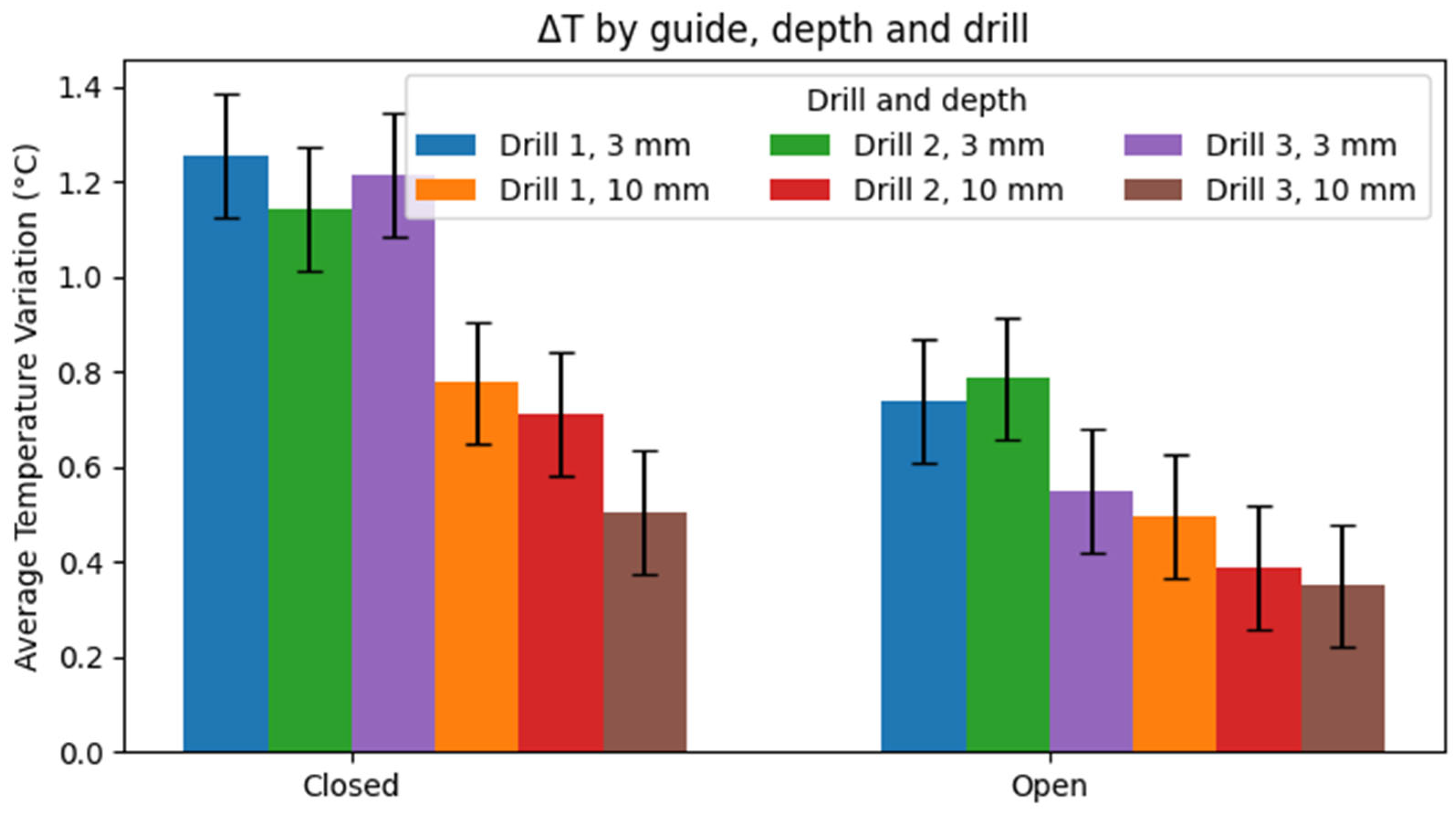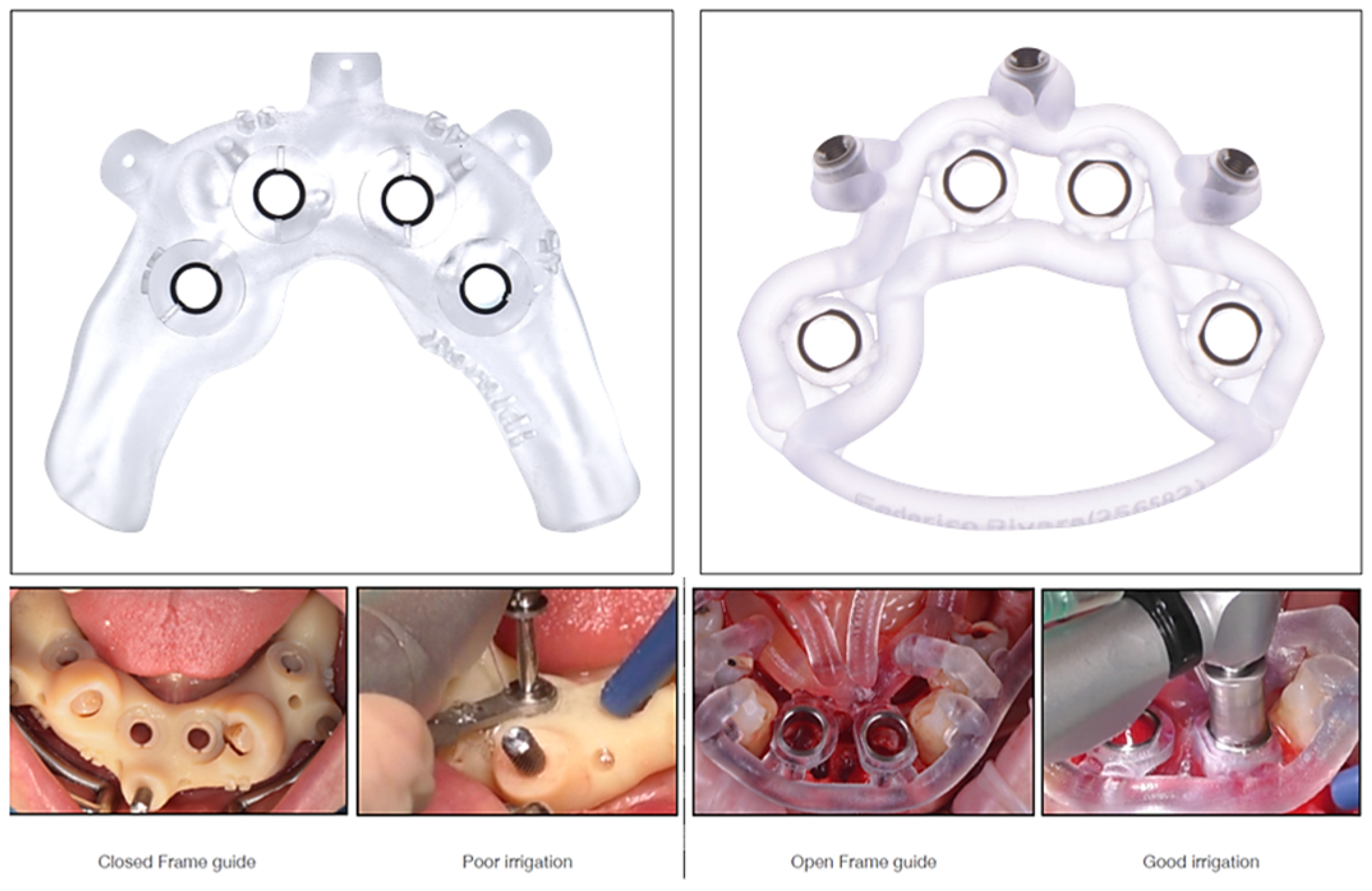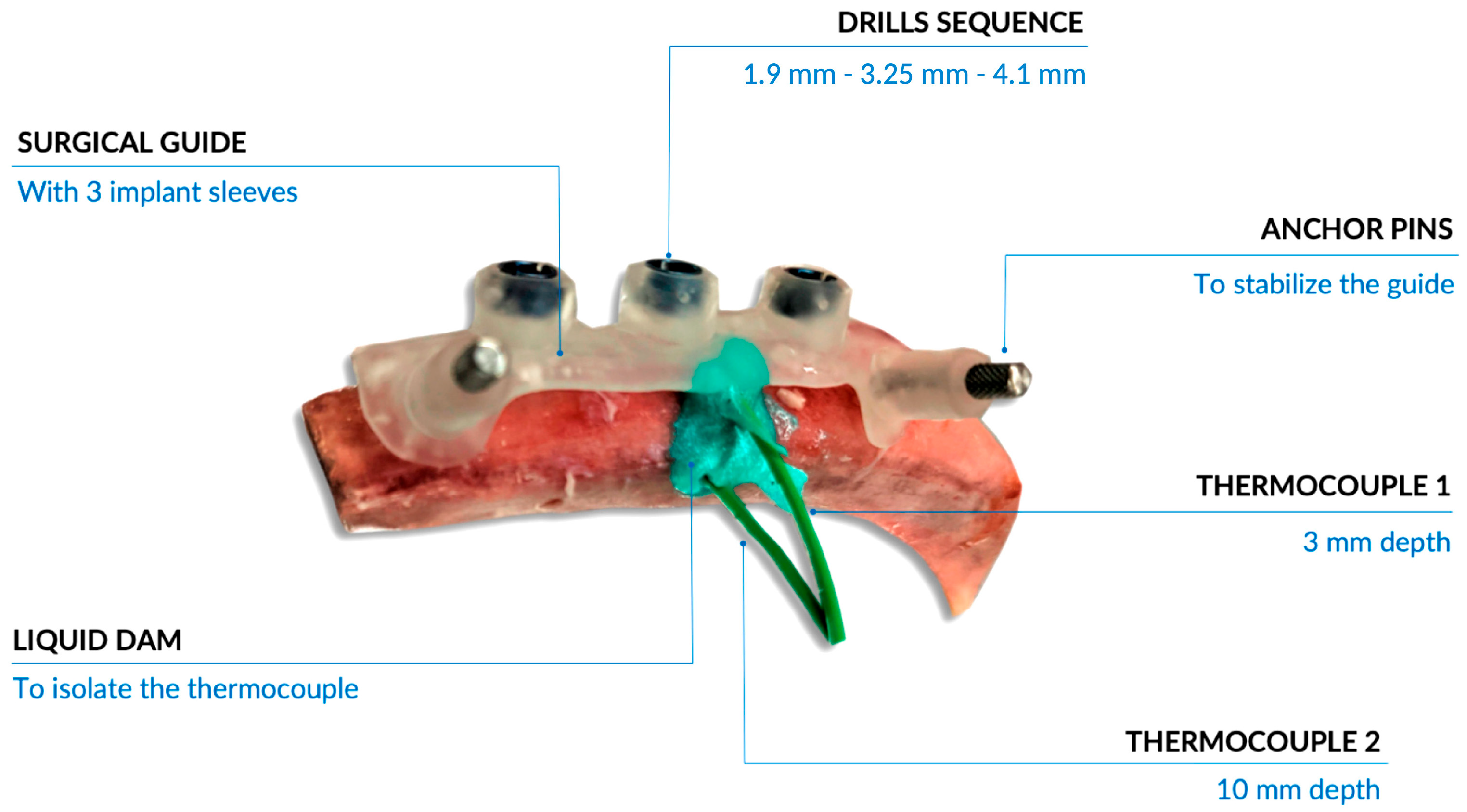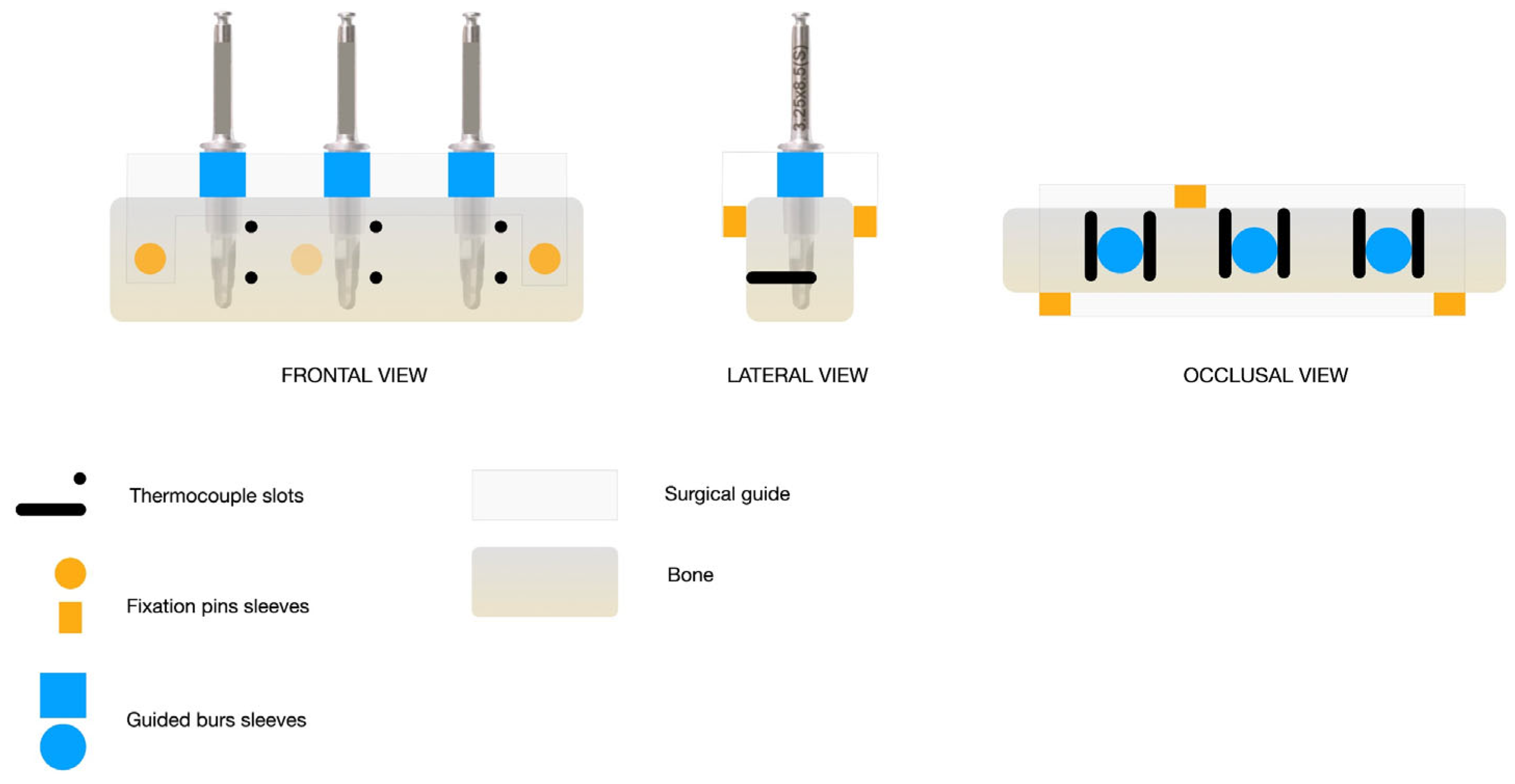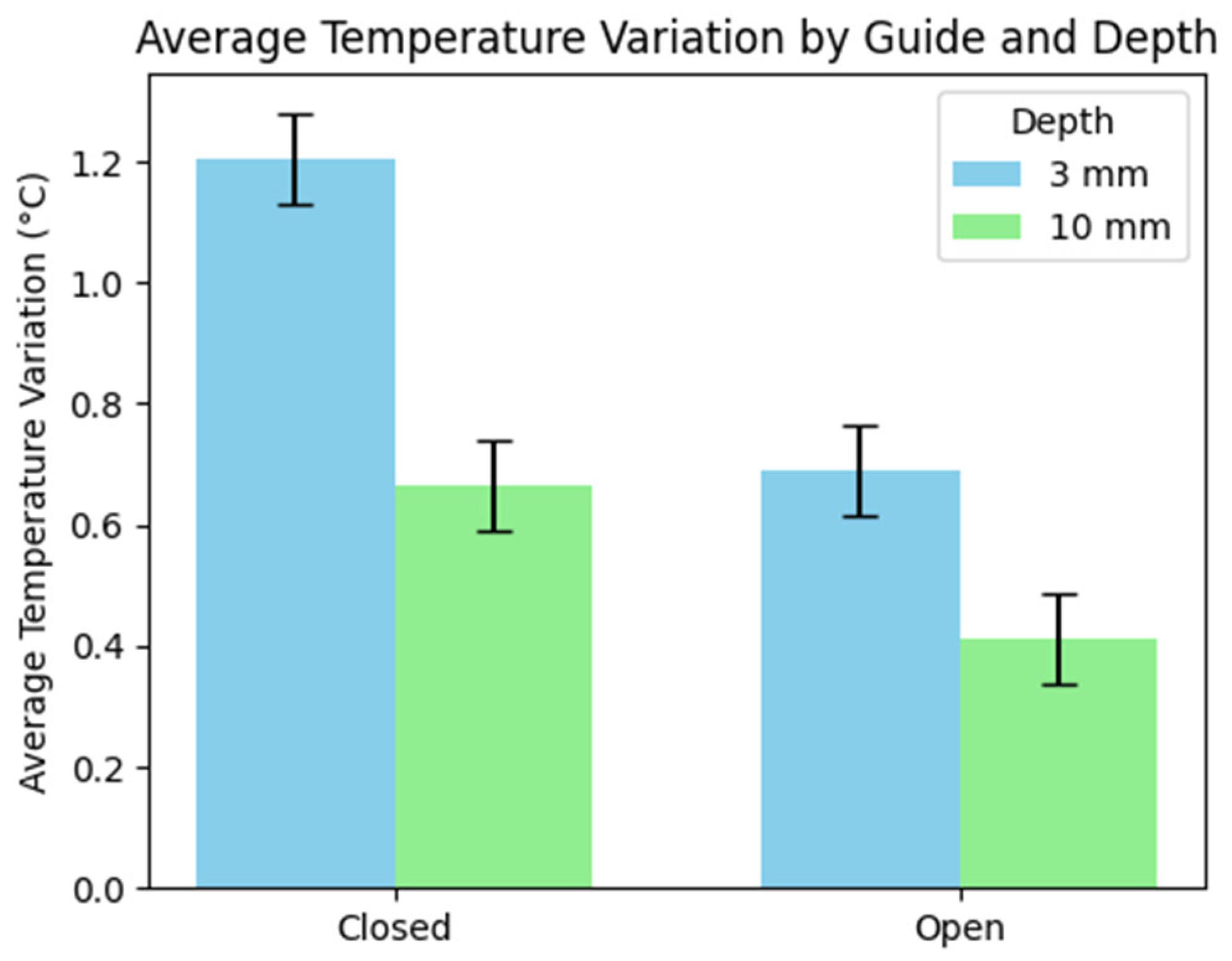1. Introduction
The rise of computer-guided implant surgery has brought several advantages for both the clinician and the patient. Compared to conventional free-hand surgery, one of the many advantages of guided surgery is the accuracy in prosthesis-guided implant positioning but also a safer and more respectful procedure for noble anatomical structures, the reduction of surgical time and a reduced post-operative discomfort for the patient due to less invasive flaps or a flapless approach [
1].
However, one of its potential disadvantages is the risk of excessive bone overheating because of poor irrigation, particularly in difficult-to-reach areas, like the posterior jaw. When a surgical guide is not used and a conventional flap approach is followed, the irrigation solution can more easily reach the drill, effectively controlling heat production. In contrast, the sleeve and the body of the surgical guides can prevent the diffusion of the refrigerant solution, causing overheating. Moreover, in a flapless guided surgery, both the thickness of the mucosa, the height of the surgical guide’s sleeves and the distance between the sleeve’s head and the osteotomy (the so called ‘off-set’, which is around 1 cm for almost all manufacturers) must be considered.
Bone overheating can jeopardize osseointegration, implants’ survival and surgical success [
2,
3]. Histologically, excessive heating can stop the turnover of bone tissue, causing hyperaemia, necrosis, fibrosis, osteocyte’s degeneration and increased osteoclastic activity, hence compromising osseointegration. So, albeit bone is a tissue rich in cells and vascular structures, if the cells are severely damaged by the frictional heat generated during osteotomy, healing could be delayed or even jeopardized. The first article that demonstrated how susceptible bone tissue is to heat damage was by Eriksson and Albrektsson in 1983, setting the temperature threshold for bone necrosis to 47 °C after 1 min [
4].
Overall, many operator-dependent factors can influence heat generation, including the load applied [
5], the drilling speed [
6] and the drilling time [
3]. Moreover, whether a conventional expansion is performed compared to a one-step drilling [
7], or if an intermittent compared to continuous drilling [
8] is performed, may significantly impact on the generated temperature. Other relevant factors are producer-related, including the shape and dimension of the drill [
9] and how sharp they are [
4], or site-related, like cortical thickness [
10], post-extractive site condition [
11] and depth of drilling [
9], or patient-related, such as age and bone density [
12,
13].
The osteointegration process follows the same cascade of events that occur during bone repair. After a blood clot forms, phagocytic cells colonize the wound. Phagocytic activity rises during the first and third day following surgery and around this stage, bone remodeling begins. The clot is progressively reabsorbed and replaced by granulation tissue, caused by the ingrowth of blood vessels, leukocytes, and mesenchymal cells. The granulation tissue is initially replaced by a provisional soft connective tissue (fourth day), then by osteoid. Eventually, the bone calcifies and becomes thicker thanks to the deposition of hydroxyapatite crystals within the collagenic network [
14,
15,
16].
Since bone necrosis is one of the main reasons for implant failure during osteointegration [
2,
3,
4], nowadays many manufacturers have a greater interest in modifying the guide design for guided surgeries, preferring an open frame to a closed one (
Figure 1).
While there is an obvious biological rationale in hypothesizing that an open frame compared to a closed frame would improve irrigation, to the best of our knowledge, this is the first study investigating and quantifying the effect of guide design on heat generation during implant site preparation.
2. Materials and Methods
2.1. Study Design
In this ex vivo study, two experimental groups were compared, according to two types of surgical guides (closed- vs. open- frame) employed, with the same surgical set-up and the same external profile size. Each group included 8 pig ribs, with 3 implant sites each, for a total of 24 implant sites per group. Temperature was measured at 3 mm and 10 mm depth for each of the three drills used.
2.2. Guides and Drilling Equipment
An intraoral scanner (Carestream CS3600, Carestream, Rochester, NY, USA) was employed for scanning the ribs. The STL file was then imported into a software for guided surgery (Implant Studio, 3shape Global, 2024.1, Copenhagen, Denmark) in order to design closed and open guides. Both guides consisted of three metal sleeves and three anchor pins. Two anchor pins were positioned on one side of the rib and one on the opposite side to reach a higher level of stability (
Figure 2).
Implant sites were created through a surgical handpiece powered by a TMM3-N implant motor (IDI evolution Srl, Concorezzo, Italy), equipped with a patent for reading thermal risk. For the drilling of each implant site, three different drills from the Certain® Navigator® System guided surgery kit (BIOMET 3i™, Palm Beach Gardens, FL, USA) were used: the first drill was the Twist Drill (1.9 mmD), the second drill was the Shaping Drill (3.25 mmD × 10 mmL), and the third drill was the Shaping Drill (4.1 mmD × 10 mmL). The rotation speed was set at 800 r/min, and the refrigerant fluid used was 0.9% saline water. Irrigation was provided with a continuous flow of external irrigation provided by the physiodispenser attached to the handpiece.
2.3. Temperature Measurements and Recording
The thermocouple sensors were positioned perpendicular to the implant site, at less than 1 mm from it and at two different depths (3 and 10 mm), inside surgically created holes of 2 mm diameter (
Figure 3), isolated from the external environment thanks to a liquid dam layer (
Figure 2).
The workflow is simplified in
Figure 4: the first step was the 3D scanning of the ribs; secondly, implant planning was performed on the STL files; then, the two types of guides were 3D printed; and finally, the drilling procedure was performed with thermocouples in position. Temperatures were detected at 3 mm and at 10 mm for each of the three drills used, with the aim to record temperature variations closed to the cortical bone and more in depth.
A 2-core K-type thermocouple (RS components, Corby, UK) with a Teflon PFA sheath (able to detect ΔT from −75 °C to +260 °C) was used. The thermocouple was connected to a 4-channel NI 9219 C Series universal module (National Instruments, Austin, TX, USA), inserted inside an NI cDAQ™-9171 chassis (National Instruments, Austin, TX, USA) with a sampling rate of 50 Hz, which was connected via USB port to a laptop.
Temperatures were recorded using a data acquisition software, programmed by an expert researcher in the field of thermographic measurements. The software generated a .mar file, which was then converted into .excel format using the MATLAB software R2025a (MathWorks Inc., Natick, MA, USA), containing all the temperature measurements recorded with a Δt of 0.02 s.
2.4. Statistical Analysis
A dataset containing all experimental variables was created using IBM® SPSS® Statistics (IBM, Armonk, NY, USA). Temperature variation—defined as the difference between the maximum temperature recorded during drilling and the baseline temperature—was treated as the dependent variable. Three independent variables were included in the analysis: type of surgical guide (open vs. closed), drill type (initial drill = Drill 1, intermediate drill = Drill 2, and final drill = Drill 3), and drilling depth (3 mm vs. 10 mm). Levene’s test for equality of error variances was performed on the temperature variation data to assess the homogeneity assumption across the experimental groups. This test evaluates the null hypothesis that the error variance is equal among all groups defined by the full-factorial model, which included the main effects of Guide, Drill, and Depth as well as their two- and three-way interactions. A factorial ANOVA using Type III sums of squares was performed to evaluate the effects of these factors and their interactions on temperature variation, and post hoc pairwise comparisons (adjusted using the Sidak method) were conducted as needed. Statistical significance was set at a p-value < 0.05.
Graphical representations (box plots and error bars) were produced to visualize data distributions across the levels of each factor using the Matplotlib Library 3.10.0 for Python.
3. Results
A total of 48 implant sites were prepared on the pig ribs, equally assigned to the closed- (n = 24) and the open-frame guide (n = 24) groups. Each group was further divided according to drill type (Drill 1, Drill 2, and Drill 3) and drilling depth (3 mm vs. 10 mm), creating a fully factorial structure. A univariate analysis of variance (ANOVA) was performed using Type III sums of squares to examine the effects of Guide (Closed vs. Open), Drill (1, 2, 3), and Depth (3 mm, 10 mm), as well as their interactions. Levene’s test yielded an
F value of 6.156 (
p < 0.001), indicating a significant difference in variances, but the balanced nature of the design supported the reliability of the ANOVA results. No two-way or three-way interactions among Guide, Drill, and Depth were significant (all
p > 0.05;
Table A2). The Guide × Depth interaction approached significance (
F = 3.06,
p = 0.081), indicating that the guide-related temperature gap was somewhat larger in the cortical layer but followed the same direction at both depths.
Figure 5 displays the estimated marginal means (EMMEANS) of temperature variation for each drill type at 3 mm (left panel) and 10 mm (right panel). In these plots, blue lines represent the closed-frame guide, whereas green lines represent the open-frame guide. Each data point corresponds to a particular drill type (Drill 1, Drill 2, Drill 3), and the
p-values comparing the two guide types are shown beneath the x-axis.
Across all three drills, the closed-frame guide produced higher temperature increases than the open-frame guide, especially at 3 mm, where cortical bone tends to generate more frictional heat.
Table 1 provides the numerical EMMEANS (±standard error) for each combination of Guide, Drill, and Depth. Because these model-based means adjust for other factors, they clarify how guide type, drill type, and drilling depth can influence heat production independently from the others.
Figure 6 illustrates an alternate view of these data, aggregated across the three drills, which clarifies the marked difference between the two guides at the 3 mm level. This discrepancy persisted at 10 mm, albeit to a lesser extent, suggesting that deeper bone layers experience lower overall heating. An extended breakdown of ΔT by each of the three drill bit sizes at both 3 mm and 10 mm depths is provided in
Appendix A (
Figure A1).
Figure 7 shows the raw distribution of peak temperature rises (ΔT) for every osteotomy: while medians stayed below 1 °C in all conditions, the closed-frame guide exhibited a wider spread—particularly at the cortical 3 mm level, where occasional outliers exceeded 5 °C—whereas the open-frame guide kept nearly all values within 2 °C.
The temperature gap between closed and open guides ranged from about 0.2 °C to 0.67 °C, with the largest discrepancies consistently observed in the 3 mm cortical zone.
While descriptive statistics (i.e., raw means ± standard deviations) are available in
Appendix A, the ANOVA results are available in
Appendix A indicating that guide (
F = 26.338,
p < 0.001) and depth (
F = 30.131,
p < 0.001) constituted the only significant main effects on temperature variation.
Overall, the closed-frame guide enhanced temperature variations by approximately 0.38 °C (p < 0.001) relative to the open-frame guide, when considering all drills and depths.
Likewise, the 3 mm measurements produced a roughly 0.41 °C higher temperature than the 10 mm measurements (p < 0.001), suggesting increased sensitivity of the denser cortical region to frictional heat.
Post hoc Sidak comparisons further highlighted the influence of cortical bone on the guide effect, with a mean difference of around 0.515 °C at 3 mm (
p < 0.001) versus 0.253 °C at 10 mm (
p = 0.017) between closed and open guides (
Table 2).
Table 3 offers a detailed view of how each drill type at each depth contributed to the differences between conditions. The Drill factor (Drill 1, Drill 2, Drill 3) showed no significant overall effect (
p = 0.205), although certain combinations at 3 mm—particularly involving Drill 3—revealed noticeably lower heating with the open guide (
Table 3). Remarkably, none of the closed-frame guide conditions exceeded the widely reported necrotic threshold of 47 °C for bone, but the data suggest that open-frame guide design facilitates irrigation more effectively, particularly in the superficial, denser cortical layer.
The lower temperature levels seen at 10 mm confirm that drilling depth alone is less critical than the combination of a closed guide design and cortical drilling, which together elevate the risk of heat accumulation more than adjustments to drill diameter or geometry.
None of the interactions involving Guide, Drill, or Depth reached statistical significance (p > 0.05), implying that the primary determinants of temperature were guide design (closed vs. open) and measurement depth (3 mm vs. 10 mm).
4. Discussion
The present ex vivo study suggested that the use of surgical guides with an open-frame design can significantly reduce bone heating when compared to closed-frame guides, with a mean difference of 0.38 °C (SD 0.75). More specifically, the results suggest that a closed guide produced at most a two-fold higher temperature rise, the greatest gap being 0.67 °C at the final drill in the cortical 3 mm zone (1.22 °C vs. 0.55 °C).
To the best of our knowledge, this is the first study that looked at the impact of surgical guide design on bone overheating. Previous studies investigated the effect of heat generation during implant site preparation, mainly comparing free-hand surgery and guided surgery, or comparing continuous drilling technique vs. intermittent drilling technique, or comparing drilling with or without irrigation [
17,
18,
19,
20,
21].
While guided surgery offers significant advantages over traditional surgery in terms of accuracy of implant positioning, reduced chair time and improved patient-reported outcome measures [
1], it is well known that the use of surgical guides leads to higher temperatures than free-hand surgery [
19,
20,
21]. Remarkably, Markovic et al. [
18] indicated that the osteotomy entry area is the most affected by temperature increase, because it is exposed to longer frictional forces and because of the high cortical bone density. Recently, Trisi et al. have also demonstrated, through an in vivo study, that there is a correlation between quantity and quality of irrigation and peri-implant bone resorption [
22], with a correlation between temperatures of 60 °C and the formation of peri-implant intrabony pockets [
23]. For this reason, it has been suggested to use a cooling channel inside the guide, as its presence can reduce ΔT [
24], although another recently published article stated that no difference was recorded between guides with external or internal irrigation [
25].
Bone irrigation is doubtlessly a pivotal factor in implant site preparation. The cooling effect of drill irrigation is necessary to avoid bone necrosis, hence for the correct osseointegration of dental implants. Since guided surgeries rely on the use of surgical guides to transfer the ideally planned implant position from the project to the mouth of the patient, understanding how the design of such guides may affect bone irrigation becomes of crucial importance. While the temperatures generated within this study are far from the ones known to cause bone necrosis, it should be remembered that this a proof of principle study in an ex vivo model, which lacks the presence of soft tissues, as well as the vascularization plexus coming from hard and soft tissues.
Reproducing in vitro the peculiar conditions that we face in clinical practice when performing a guided surgery is almost impossible, for instance, in terms of distance of the irrigation source, thickness of the soft tissues and drilling depth. However, when translating these data to the clinical scenario, the fact that an open-frame guide could reduce up to two times the temperature increase in the drilling area may offer a tangible benefit to clinicians. This would be particularly relevant in challenging scenarios, where owing to anatomical reasons (e.g., posterior/tilted implants) or limited opening of the mouth of the patient, it might be difficult to ensure appropriate irrigation of the surgical site during guided surgery or when drilling poorly vascularized/cortical bone.
Remarkably, the drilling depth seems also to have an impact on heat production, as temperature variations were higher at 3 mm depth compared to 10 mm depth when using both guides. This may be due to the fact that the cortical portion of the bone is exposed to frictional forces for a longer time and because the cortical bone has a higher friction coefficient than the trabecular bone. Both guides seem to be more effective at 3 mm depth than at 10 mm depth in reducing overheating, probably because the deeper we drill, the more challenging it becomes for the cooling liquid to reach the bone [
9]. However, a similar result has been observed for closed guides, since the increase in temperature seems higher at the cortical level than at the maximum drilling depth, suggesting that the drilling depth has less impact than the bone density, regardless of the type of surgical guide used. Our data are in line with a previous study that found a higher ΔT on the bone surface compared to deeper sites, both in case of guided surgery (with flap and flapless) and conventional surgery (with flap and flapless) [
20]. Conversely, another study by Cordioli and Majzoub [
9] reported that ΔT at 8 mm was higher than at 4 mm in a free-hand surgery with a flap approach.
While it may seem obvious that an open-frame vs. a closed-frame guide may facilitate the irrigation of the drilling site, the clinical relevance of such difference and the impact on overall bone heating needs to be clarified in vivo. It should also be recognized that the digital design of such open guides requires a more experienced operator as it cannot take advantage of semi-automatic design systems. This may have an impact in terms of production time and costs.
This study presents some limitations. The most important is related to the impossibility to reproduce ex vivo the peculiar conditions of the oral environment, including the presence of soft tissues that can isolate the bone from the refrigerant, blood vessels and saliva. As a matter of fact, in the absence of blood flow, surrounding soft tissues and a physiological starting temperature, heat dissipation differs markedly from in vivo bone, so the absolute maxima reached in this set-up do not translate to the 47 °C osteonecrosis threshold used clinically, but remain in the 25–27°C interval. Our primary objective was, therefore, to compare the relative thermal load created by the two guide designs under strictly identical laboratory conditions in a proof-of-concept study. However, we should recognize that the use of an avascular pig bone may not allow to reproduce the characteristics of human jaws in terms of bone physiology, density and resistance to the drill penetration. As such, we should be careful in extrapolating these outcomes to the clinical setting, since this model may be inadequate to fully elucidate the mechanisms underlying implant failure related to overheating, while serving the scope of creating a proof of principle.
Nevertheless, the use of thermocouples allowed standardized temperature recording. Thermocouples can measure the temperature with high accuracy even on wet bone surfaces, in agreement with previous studies [
19,
20,
26], although temperature is measured in a point-like manner and requires the precise positioning of probes at the drilling site. Such technology cannot be applied in the human jaw, as it would require drilling two extra holes in the patient’s bone to secure them. Moreover, there are anatomical limitations that should not be underestimated and which make the intraoral positioning of such devices quite challenging.
Another possible method for future in vivo temperature measurements is infrared thermography, which does not require accurate positioning of any specific probes [
18], but it strictly requires dry conditions [
27].
It should also be noted that in this study it was not possible to standardize the drilling force, and this represents a limitation. However, since bone drilling is a manual procedure, such standardization would also not be feasible in the clinical setting. The same experienced operator performed all the drillings by following the same protocol he would use in a clinical setting, with back-and-forth movements to allow the removal of bone debris, thus reducing the risk of overheating.
